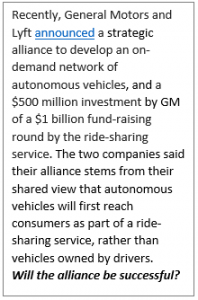A strategic alliance is an agreement between two or more organizations or companies to cooperate in a specific business activity, so that each benefit from the strengths of the other to achieve an objective. Alliances typically involve sharing strategy, revenues, costs, and/or risks.
The formation of strategic alliances has become more prevalent over the last two decades in response to globalization and increasing uncertainty in the business environment. Some estimates suggest that 35% of the revenue of the largest 1,000 firms in the United States is a result from strategic alliances, yet the failure rate for alliances hovers between 60% and 70%.
Whether you are running a multinational corporation, a not-for-profit organization, or a small business, the process to select and manage strategic alliances can be a complex and daunting undertaking. Taking advantage of proven methodologies and techniques to make fact-based decisions will help build consensus and drive better alliance results.
Set up a Governance Board

The first order of business, particularly in larger organizations and companies, is to set up a governance structure. This may take the form of a partner alliance strategy council or review board comprised of cross-functional leaders and representatives who:
- Set and maintain the alliance strategy and policy
- Approve the alliance management process and procedures
- Approve strategic partnerships that meet threshold criteria
- Allocate resources (funding and people) to establish and manage alliances
- Commission and retire alliance management teams
- Review alliance performance and plans at periodic checkpoints
- Resolve conflicts arising from the alliance management teams
Select Strategic Partners using a Decision Model
The task of selecting and managing strategic partners is a classic portfolio management challenge. There are many factors to consider, alternatives to evaluate, and decisions to be made. Here, an emphasis should be placed on analyzing available data and engaging internal stakeholders to leverage their experience, insights, and judgments. This is best handled by building one or more decision models to enable multi-criteria decision-making, as I discussed in my October blog Using Decision Models for Multi-Criteria Decision-Making.
Depending on the number and mix of strategic alliances in play, the analysis can be improved by organizing and managing the alliances in portfolios, using one or more of the following attributes:
- Category (e.g, products, services, branding, marketing, and loyalty)
- Type (e.g., joint venture, outsourcing, marketing, distributors, licensing, franchising, and R&D)
- Geography (e.g., city, state, region, country, or continent)
- Tier (by duration) (e.g., short-term, mid-term, and long-term)
- Industry Vertical (e.g., entertainment, financial, healthcare, real estate, sports, and technology)
When evaluating potential strategic alliances, it’s important to evaluate quantitative data and criteria, as well as qualitative factors such as cultural fit. The top five of the eight most cited reasons for the failure of an alliance are the direct consequence of cultural mismatch, with “cultural mismatch” itself cited as #7.
During this phase, it’s not too early to begin to define “how” the alliance will work, even if at a conceptual level. Once there is agreement on the conceptual approach, representatives from both strategic partners should define how the parties will work together by collaborating on the business process and procedures.
Manage Strategic Alliances as a Portfolio
Once a strategic alliance program has been formed, it must be managed. This introduces a whole new set of evaluation criteria and an additional decision model for multi-criteria analysis and decision-making. For example, is the strategic partner meeting its commitments? Have there been breaches of the alliance agreement? Is the alliance meeting its objective? Are there unacceptable risks (e.g., financial, operational, intellectual property, reputational)? These criteria should feed into a semiannual or annual portfolio review to determine which strategic alliances should be continued, re-structured, or terminated.
In closing, to successfully manage a strategic alliance program and out-perform the 60-70% failure rate, an organization must have a governance and management commitment commensurate with the investment and risk levels associated with program. That commitment should include using proven portfolio management methodology, and multi-criteria decision-making models to build group consensus and make fact-based decisions.
© 2018 Definitive Business Solutions. All Rights Reserved.
John Sammarco has thirty-five years of experience leading, managing, and consulting to top public and private sector organizations, and has over twenty years of experience in facilitating complex group decisions. John founded Definitive Business Solutions in 2003, which provides world-class group decision-making solutions to increase efficiency, boost ROI, and reduce risk associated with business and technology investments. In 2016, John developed Definitive Pro™, which helps groups build consensus and make multi-criteria decisions.



